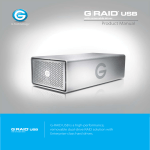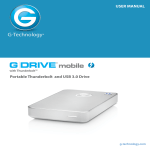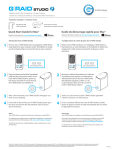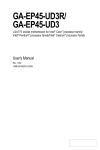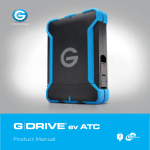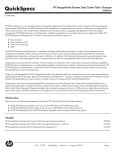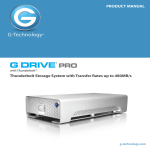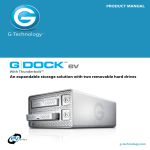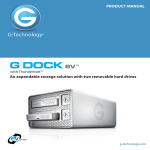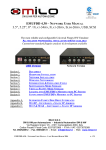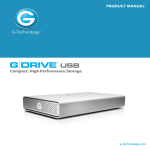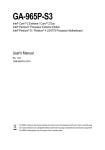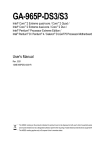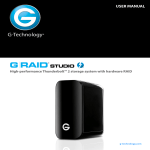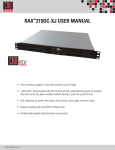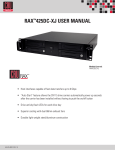Download User`s Manual - G
Transcript
Product Manual G-RAID® with Thunderbolt™ is a high-performance, removable dual-drive RAID solution with Thunderbolt, USB and Enterprise-class hard drives. Table of Contents Table of Contents Safety & General Use Maintenance for Your Drive Safety Precautions.......................................................4 Initialize the Drive for Mac..................................... 30 Backup Your Data.........................................................5 Restore the Drive Icon............................................. 34 Reformat with Partitions........................................ 35 About Your G-RAID with Thunderbolt Replace a Failed Drive Module............................. 41 Introduction...................................................................7 What’s in the Box .........................................................8 Using Your Drive on Windows System Requirements.................................................8 Windows Use............................................................... 44 Overview of the Drive ................................................9 Cross Platform Use ................................................... 44 Activity & Failure LED............................................... 10 Support & Warranty Using Your Drive on Mac Technical Support..................................................... 48 Easy Installation for Mac......................................... 12 Limited Warranty....................................................... 49 Optimize Performance............................................ 12 Copyright...................................................................... 51 Use With Time Machine ......................................... 13 Disconnect the Drive .............................................. 15 Using RAID Modes Supported RAID Modes.......................................... 17 G-Technology Assistant Utility............................. 18 G-Technology Assistant Menu............................. 19 G-RAID with Thunderbolt Config. Utility......... 20 Configure the RAID Mode for Mac..................... 21 RAID 1 Degraded Mode for Mac......................... 25 Configure the RAID Mode for Windows........... 25 RAID 1 Rebuild for Windows................................. 28 p.2 Safety & General Use • Safety Precautions.....................................p. 4 • Backup Your Data.......................................p. 5 Safety & General Use Safety Precautions G-RAID with Thunderbolt’s warranty may be void as a result of the failure to respect the precautions listed here. If you detect a problem with your drive, please contact our Technical Support department. If the product is returned with damage caused by improper handling, the warranty will be void and liability will rest with the user. Please read our Limited Warranty. • • • • • Servicing: Your drive contains no user-serviceable parts. If it appears to be malfunctioning, have it inspected by a qualified Technical Support representative. Moisture: Place the device away from moisture or liquids. To reduce the risk of damage, do not expose this drive to rain or moisture. Do not use it in damp or wet conditions. Never place objects containing liquids on the drive as they may spill into its openings. Ventilation: Place the device in a vented area. The drive should never be placed near or over a radiator or heat source. Temperature: Do not expose this drive to temperatures outside the range of 5°C to 35°C (41°F to 95°F); or to operational humidity beyond 5-80%, non-condensing, or nonoperating humidity beyond 10-90%, non-condensing. Avoid placing your drive near a source of heat, or exposing it to sunlight (even through a window), or in an environment that is too cold or humid. Physical Damage: Do not place heavy objects on the drive. Never use excessive force on your drive. p.4 Safety & General Use Backup Your Data The disk drives contained in your G-RAID with Thunderbolt device are delicate electronic instruments and are susceptible to damage due to excessive physical shock. Under no circumstances will G-Technology be held liable for the recovery or restoration of lost data. Any loss, corruption or destruction of data while using a G-Technology drive is the sole responsibility of the user. Make Two Backups To help prevent the loss of your data, we highly recommend that you keep TWO copies of your data in separate storage locations. Keep one copy on your G-Technology drive. Keep a second copy on your internal hard drive, another G-Technology drive or a form of removable storage media. If possible, it is advisable to keep your data in two physically disparate locations for added safety. p.5 About Your G-RAID with Thunderbolt • Introduction.....................................................p. 7 • What’s in the Box............................................p. 8 • System Requirements..................................p. 8 • Overview of the Drive..................................p. 9 • Activity & Failure LED....................................p. 10 About Your G-RAID® with Thunderbolt™ Introduction Thank you for purchasing G-RAID with Thunderbolt from G-Technology. The G-RAID with Thunderbolt is a high-speed, low-cost RAID that provides an ideal storage solution for content creation professionals. With its unique industrial design and all-aluminum housing, G-RAID with Thunderbolt is the de facto standard for many post-production facilities worldwide. G-RAID with Thunderbolt features dual Thunderbolt 2 ports and a USB 3.0 interface. When connected via the Thunderbolt interface, G-RAID with Thunderbolt provides data transfer rates up to 440MB/second to support the most demanding professional content creation applications such as Final Cut Pro®, Avid® Media Composer and Adobe Premiere®. With its built-in RAID controller, the G-RAID with Thunderbolt is not tied to a single workstation and can be easily transported for use in the edit bay or on the road. The unit contains an internal RAID controller and can be configured in RAID 0 (Performance), RAID 1 (Protected) or JBOD (Just a Bunch of Disks) mode. In the RAID 1 or JBOD mode of operation, if a single hard drive failure occurs, your data will still be safe and accessible (in RAID 1 all your data is safe, whereas in JBOD all your data stored on the good drive is safe). p.7 About Your G-RAID® with Thunderbolt™ What’s in the Box The following items are included in the box: • • • • G-RAID with Thunderbolt storage solution with two removable disk drives Thunderbolt cable (compatible with Thunderbolt 2 & 1 ports) USB cable (3.0; backward compatible with USB 2.0 ports) External AC power supply and cable If any items are missing, please contact G-Technology at [email protected] or call (888) 426-5214. System Requirements G-RAID with Thunderbolt supports the following operating systems: • • Mac OS® 10.9.2 + Windows® 8.1, 8 and 7 (via reformat) The drive has been preconfigured in RAID 0 (Performance) mode for use with Mac OS® systems, formatted as “HFS+ with Journaling.” p.8 About Your G-RAID® with Thunderbolt™ Overview of the Drive The following diagram shows the helpful features of your G-RAID with Thunderbolt. The compact and quiet G-RAID with Thunderbolt features two removable HGST Enterpriseclass 7200 RPM SATA III hard drives. It has a uniquely designed all-aluminum enclosure with an activity/failure LED in the front panel. The rear panel features a Kensington® security slot, dual Thunderbolt 2 ports (daisy chain up to 5 peripherals), a high-speed USB 3.0 port, a DC power port and a soft-touch on/off switch. The features combine to provide universal connectivity and industry-leading performance. All cables are included. Kensington® Security Slot Power/Failure LED Thunderbolt Ports DC In On/Off Switch USB 3.0 Port p.9 About Your G-RAID® with Thunderbolt™ Power, Activity and Failure LEDs G-RAID with Thunderbolt contains LEDs for power, drive activity and drive failure. The “G” LED on the front panel of the enclosure indicates Power (White) or RAID Failure (Red). There are also Drive Activity LEDs and Drive Failure LEDs located on the drive modules. The following table explains the meaning of each combination of LEDs on the drive. State Power LED (Front Panel) Drive Activity (Drive Module) Drive Failure (Front Panel) Drive Failure (Drive Module) System Initialization Flash White On Flash Red Off System Ready On On Off Off Disk Activity On Flash Blue Off Off Disk 1or Disk 2 Failure (RAID 0) Off Off Red On Purple On Fail Safe Mode (RAID 1) Disk 1 Failure Off Off Red On Red On Fail Safe Mode (RAID 1) Disk 2 Failure Off Off Red On Red On The power light will glow when power is applied. The drive activity LED’s on the drive modules will flash as data is transferred to or from the hard drive. In the event of a disk drive failure, the RED drive failure LED located on the front panel will illuminate. In RAID 1 mode - the red light on the drive module indicates the failed drive. If a drive failure occurs in RAID 0 mode then the LED in the front panel turns constant RED. • • • If configured in protected RAID 1 mode, all the data stored on the system will be intact. If configured in JBOD mode, only the data in the bad drive will be lost; the rest of the data will be intact. If configured in RAID 0 mode, all data will be lost. Please contact Technical Support for help if the “G” logo or drive LED is blinking or solid RED, indicating drive failure. p.10 Using Your Drive on Mac • Easy Installation for Mac..........................p. 12 • Optimize Performance.............................p. 12 • Use With Time Machine...........................p. 13 • Disconnect the Drive................................p. 15 Using Your Drive on Mac® Easy Installation for Mac G-RAID with Thunderbolt attaches to your computer via a Thunderbolt or USB 3.0 port. Connect the power cord to the unit and plug the other end into a surge protector or wall outlet. Press and hold the power button until the unit turns on. The drive will automatically mount on the desktop if you are running Mac OS X. Kensington® Security Slot Thunderbolt Ports DC In On/Off Switch USB 3.0 Port Optimize Performance G-RAID with Thunderbolt can be connected to any Mac or Windows machine equipped with a Thunderbolt port or a USB 3.0 or USB 2.0 port. If you are going to use the drive on a Windows machine, read Using Your Drive on Windows. p.12 Using Your Drive on Mac® Use with Time Machine® Your G-RAID with Thunderbolt can be easily used as a backup drive via Time Machine when connected to a Mac. Time Machine is an application that ships with your Mac and provides automatic file backup. The following steps will quickly set up G-RAID with Thunderbolt as a Time Machine backup location. When you attach your G-RAID with Thunderbolt for the first time, the Time Machine dialog box should automatically appear. Click the Use as Backup Disk button. If the Time Machine dialog box does not launch, go to the Apple Menu > System Preferences. Click on the Time Machine icon. The Time Machine Preference panel will open. Click the Select Backup Disk button. p.13 Using Your Drive on Mac® In the subsequent dialog box, select the G-RAID with Thunderbolt. Click the Use Disk button. Make sure the Time Machine switch is set to ON. You can set its options by clicking the Options button. Do this to choose volumes, folders, or files you do NOT want to backup. G-RAID with Thunderbolt will now backup your important files automatically with Time Machine. It’s really that easy! p.14 Using Your Drive on Mac® Disconnect the Drive A great feature of G-RAID with Thunderbolt is its ability to connect and disconnect while your computer is running. To prevent failures and/or data loss, it is important to follow the steps below when disconnecting or “unmounting” the drive from your computer. 1. Before powering down and disconnecting the drive, unmount the system by dragging the G-RAID with Thunderbolt icon to the trash located in the dock. Keyboard shortcut: Select the drive icon and hit Command+E. 2. It is safe to remove the drive from your system when the drive icon is no longer present on your desktop. 3. To power off G-RAID with Thunderbolt, press and hold the On/Off power button until the unit shuts down. Helpful Links • To use G-RAID with Thunderbolt on Windows, go to Windows Use. • To use G-RAID with Thunderbolt on Mac and Windows together, go to Cross-Platform Use. p.15 Using RAID Modes • Supported RAID Modes.......................................................... p. 17 • G-Technology Assistant Utility............................................. p. 18 • G-Technology Assistant Menu ............................................. p. 19 • G-RAID with Thunderbolt Configuration Utility............. p. 20 • Configure the RAID Mode for Mac...................................... p. 21 • RAID 1 Degraded Mode and Rebuild for Mac................. p. 25 • Configure the RAID Mode for Windows............................ p. 25 • RAID 1 Rebuild for Windows................................................. p. 28 Using RAID Modes Supported RAID Modes G -RAID with Thunderbolt is preconfigured in RAID 0 (Performance) mode, for use with Mac OS systems. The drive can also be configured in RAID 1 (Protected) mode or JBOD (Just a Bunch of Disks) mode. The following table explains the advantages and disadvantages for each RAID level. RAID Level Description Advantage Disadvantage Ideal For RAID 0 Disk Striping Highest read/write performance. Storage capacity is 100% utilized. No fault tolerance. Single drive failure will result in complete data loss. Highest storage capacity utilization and highest performance. RAID 1 Disk Mirroring Complete data protection in case of a single drive failure. Read/write performance is reduced to half of RAID 0 performance. Sensitive data which requires constant backing up. High performance not required. JBOD Disk not RAIDed Storage capacity is 100% utilized. Partial data protection if a single drive fails. Read/write performance is reduced to half of RAID 0 performance. Highest storage capacity utilization when partial data loss is acceptable. To change the RAID mode of G-RAID with Thunderbolt, follow the steps in Configure the RAID Mode. RAID 0 (Performance) G-RAID with Thunderbolt ships in RAID 0 (Performance) mode. This RAID mode is ideal for maximizing your throughput when video editing. In RAID 0 mode, the drives are combined and data is split between the two drives for increased performance. RAID 1 (Protected) RAID 1 is great for protecting and securing data, making it ideal for sensitive data, but it operates at the speed of a single drive. In RAID 1, the array will be at 50 percent of its total capacity as the same data is written or mirrored to both drives simultaneously. JBOD (Just a Bunch of Disks) JBOD mode is great for maximum capacity utilization without fear of losing all your data, as in the case of RAID 0, but they each operate at the speed of a single drive. Each drive shows up as it’s own separate volume or storage location. p.17 Using RAID Modes G-Technology Assistant Utility The G-Technology Assistant (GTA) utility was created to enhance the user experience of G-Technology storage solutions such as G-RAID with Thunderbolt. The utility has two functions: 1) to provide notifications of the G-RAID with Thunderbolt status and the current drive configuration, and 2) to quickly launch the G-RAID with Thunderbolt RAID Configuration Utility. The GTA is available for download from www.g-technology.com/support. Note that the utility has an auto-update feature for your convenience. Recommended Installation When you first set up G-RAID with Thunderbolt, you will want to install the GTA on your computer. The utility provides useful notifications and shortcuts to enhance your experience with G-RAID with Thunderbolt. To install the G-Technology Assistant utility, follow the on-screen instructions. Once you have successfully completed the installation, the utility will be accessible from the Mac OS menu bar and/or from the Applications folder. The following is a quick summary of the utility and its functionality. If you have questions, please visit www.g-technology.com/support. p.18 Using RAID Modes G-Technology Assistant Menu There are helpful menu items in the G-Technology Assistant (GTA) utility. Once G-Technology Assistant has been successfully installed, the utility’s “G” icon will appear in your menu bar. By selecting this icon, the G-Technology Assistant menu will appear. Unmount All Volumes: Unmounts supported G-Technology drives attached to the system. You will need to confirm your selection prior to unmounting the drives. Disk Utility: Opens the Disk Utility application. Support: Opens your Web browser and takes you to the G-Technology support page. Preferences: Change the preferences of GTA. p.19 Using RAID Modes The RAID Configuration Utility The G-RAID with Thunderbolt RAID Configurator is used to change the RAID level of your G-RAID with Thunderbolt. You can use any of the two Thunderbolt 2 ports or USB 3.0 port in your G-RAID with Thunderbolt with the RAID Configurator application. To configure GRAID with Thunderbolt, it will need to be the only device connected to your computer. The RAID Configurator utility is available for download from the G-Technology website at www.g-technology.com/support. There are both Mac and Windows versions of the utility. Please download the right utility depending on the host operating system that you are using. Once you have downloaded the RAID Configurator, you should launch it directly from the mounted disk image and complete the installation process. Once installed, launch the RAID Configuration Utility and the tool shows the current status and other details of the drive similar to the image below. p.20 Using RAID Modes Configure the RAID Mode for Mac You can easily configure G-RAID with Thunderbolt’s RAID mode with the following steps. Important Note: Changing the RAID level will erase all data on the drive. Be sure all of the data and files you want to save are backed up to separate media. 1. In the G-RAID with Thunderbolt Configuration Utility, click on the Configure button. A dialog window will pop up with three options for configuring your disk set, as shown below. The dialog window will also warn you that when you configure your RAID set, all data on the drive will be erased. 2. Select your desired configuration with the RAID 0 (Performance), RAID 1 (Protected), or JBOD radio buttons. Then click the Configure button to continue. 3. Two warning windows will appear, both letting you know that the following step will erase all of your data. Click the buttons to continue. p.21 Using RAID Modes 4. A new window will appear to inform you that the configuration is successful. An Initialization dialog should appear or there is a Disk Utility button which you can open the Disk Utility window to initialize your disk. Select Done to close the configuration utility. 5. Changing the RAID mode of G-RAID with Thunderbolt will require you to re-initialize the disk with the Disk Utility application. The Disk Insertion dialog below should appear. Click the Initialize button to launch Disk Utility, if you did not open the Disk Utility from the previous window. Follow the simple steps described in the section Initialize Drive for Mac to initialize G-RAID with Thunderbolt for use with the Mac OS. p.22 Using RAID Modes NOTE: If the Disk Insertion dialog does not appear, go to Application > Utilities and open the Disk Utility program. Once Disk Utility is open, you are ready to initialize and partition G-RAID with Thunderbolt for use with Mac OS. RAID 1 Degraded Mode and Rebuild for Mac If your G-RAID with Thunderbolt is in RAID 1 configuration and either a single drive failure occurs or if a member of the RAID 1 set is removed, then the active drive will operate in degraded mode. What is Degraded Mode? In a two-drive RAID 1, if one of the drives fails or if one of the drives is removed then the active drive keeps the user data intact but without any fail-safe mechanism until the RAID is rebuilt. This state of operation is called degraded mode. 1. If the G-RAID with Thunderbolt is operating in degraded mode, launch the G-RAID Configuration Utility. The RAID status will show as degraded in the information window as shown in the image below. p.23 Using RAID Modes 2. The Rebuild button will become ENABLED at this point so that you have the option to rebuild the RAID 1 set. 3. To rebuild the RAID 1 set, please insert a new drive in place of the failed or removed drive. Note: While replacing the failed drive make sure the G-RAID with Thunderbolt is powered off. If this new drive is not formatted then the Disk Utility function will automatically launch, allowing you to format the drive. If this replacement drive is formatted then you are ready to rebuild the RAID set. 4. Once you click on the Rebuild button two warning windows will appear, letting you know that the rebuild process will delete the data in the newly inserted drive. Click the YES button in both the windows to continue. Note: While the rebuild is in process please keep the G-RAID with Thunderbolt connected to the host. 5. A window will appear telling you that the rebuild process is successful. 6. Your RAID 1 is now running in protected mode again. p.24 Using RAID Modes RAID Configuration Utility for Windows The RAID Configurator is used to change the RAID level of your G-RAID with Thunderbolt. You can use any of the two Thunderbolt 2 ports on your G-RAID with Thunderbolt with the RAID Configurator application. To configure G-RAID with Thunderbolt, it will need to be the only device connected to your computer. The RAID Configurator utility is available for download from the G-Technology website at www.g-technology.com/support. Once you have downloaded the RAID Configurator .zip file you need to extract the folder which contains the RAID configuration .exe file and a .dll file. Click on the .exe file and follow the simple instructions to install the configuration utility. Once the install is complete, launch the RAID Configuration Utility. The tool shows the current status and other details of the drive similar to the image to the right. Configure the RAID Mode for Windows You can easily configure G-RAID with Thunderbolt’s RAID mode with the following steps. Important Note: Changing the RAID level will erase all data on the drive. Be sure all of the data and files you want to save are backed up to separate media. 1. In the G-RAID with Thunderbolt Configuration Utility, click on the Configure button. A dialog window will pop up with three options for configuring your disk set, as shown on the next page. The dialog window also will warn you that when you configure your RAID set, all data in the drive will be erased. p.25 Using RAID Modes 2. Select your desired configuration with the RAID 0 (Performance), RAID 1 (Protected), or JBOD radio buttons. Then click the Configure button to continue. 3. Two warning windows will appear, both letting you know that the following step will erase all of your data. Click the Continue and OK buttons to configure. p.26 Using RAID Modes 4. A new window will appear to inform you that the configuration is in progress. The next window will confirm that your G-RAID with Thunderbolt is configured in RAID 0, RAID 1, or JBOD mode. 5. Changing the RAID mode of G-RAID will require you to re-initialize the disk. For helpful information on initialization of your drive with Windows using the Disk Management, please visit www.g-technology.com/windows. p.27 Using RAID Modes RAID 1 Rebuild for Windows If your G-RAID with Thunderbolt is in RAID 1 configuration and either a single drive failure occurs or if a member of the RAID 1 set is removed, then the active drive will operate in degraded mode. 1. In the case of a degraded mode, if the G-RAID Configuration Utility is launched, then the RAID status will show as degraded in the information window as shown in the image below. 2. The Rebuild button will become ENABLED at this point so that you have the option to rebuild the RAID 1 set. 3. To rebuild the RAID 1 set, please insert a new drive in place of the failed or removed drive. Note: While replacing the failed drive make sure the G-RAID with Thunderbolt is powered off. If this new drive is not formatted then the Disk Management function will automatically launch, allowing you to format the drive. If this replacement drive is formatted then you are ready to rebuild the RAID set. 4. Once you click on the Rebuild button, two warning windows will appear, letting you know that the rebuild process will delete the data in the newly inserted drive. Click the YES button in both the windows to continue. Note: While the rebuild is in process please keep the G-RAID with Thunderbolt connected to the host. 5. A window will appear telling you that the rebuild process is successful. 6. Your RAID 1 is now running in protected mode again. p.28 Maintenance for Your Drive • Initialize the Drive for Mac......................p. 30 • Restore the Drive Icon..............................p. 34 • Reformat with Partitions..........................p. 36 • Replace a Failed Drive Module..............p. 41 Maintenance for Your Drive Initialize the Drive for Mac G-RAID with Thunderbolt is factory formatted or “initialized” for use with Mac OS. You can follow these steps to reinitialize your drive if you would like to quickly erase the contents of the drive. 1. Open the Disk Utility application. Disk Utility is located on your hard drive under Applications/Utilities/Disk Utility. The window below will appear. Your G-RAID with Thunderbolt will be displayed in the left column. 2. Select G-RAID with Thunderbolt by clicking its drive icon in the left column. Information about the drive will be displayed at the bottom of the window. 3. Select the Erase tab to view the formatting options. By default, the Format pop-up menu is set to the Mac OS Extended (Journaled) option. p.30 Maintenance for Your Drive 4. Choose the Format option you prefer. • Mac OS Extended (Journaled): This basic File System format is intended for generally formatted drives including Time Machine backup and creating separate bootable Disk Images. • Mac OS Extended Case-sensitive and Encryption options: The Case-sensitive option treats file names that are the same but with different cases as different while the Encryption option adds an additional layer of security for your personal files. p.31 Maintenance for Your Drive 5. Click the Erase button in the lower-right corner of the window. A dialog box will appear asking if you want to erase the G-RAID with Thunderbolt partition. WARNING: THIS NEXT STEP WILL ERASE ALL DATA ON YOUR DRIVE. 6. Click the Erase button to continue. A progress bar in the lower-right corner of the window will show the progress of the disk’s reformatting process. p.32 Maintenance for Your Drive 7. After the drive is re-initialized, you should automatically see the Time Machine dialog box. • • Click the Use as Backup Disk button if you want to use the drive with Time Machine. Click the Don’t Use or Decide Later buttons if you do not want to use Time Machine at this point. 8. Quit the Disk Utility program. After you reinitialize the drive, the custom icon for G-RAID with Thunderbolt will be erased. You can optionally restore this icon with the steps on the next page. p.33 Maintenance for Your Drive Restore the Drive Icon If the G-RAID with Thunderbolt drive icon was erased during the configuration process (see the previous section), you can restore the icon with the following easy steps. NOTE: This process is not required for the operation of the G-RAID with Thunderbolt. However, it will make your drive’s appearance on the computer desktop look cleaner and more accurate. 1. T o get the G-Technology icon package, go to www.g-technology.com/support and navigate to your product. There will be a link to download the icons on the product support page. 2. Once downloaded, the G-Technology icons folder shown below should load automatically. If not, double-click the zip file to open. Next, double-click the DMG file to open the G-Technology icons package. 3. Click to select the drive icon for G-RAID with Thunderbolt in the package window. Press Command+C to copy the icon. p.34 Maintenance for Your Drive 4. Select the default G-RAID with Thunderbolt drive icon on your desktop and press Command+I. This opens the Get Info window (below left). 5. Select the default icon in the Get Info window (below left). 6. Press Command+V to paste the custom G-RAID with Thunderbolt icon into the Get Info window (below right). The icon for your G-RAID with Thunderbolt has been restored and you can close the Get Info window. Your drive is now ready for use! p.35 Maintenance for Your Drive Reformat with Partitions Partitioning a hard drive is the process of dividing a hard drive into separate, discrete sections called volumes. Each volume works like a separate disk. You can create up to 16 different partitions on a hard drive in Mac OS X, and each partition can be a different size and format. With hard drives getting bigger, it is useful to partition your hard drive so you can use sections of its space for different purposes. For instance, you can segment user data from backup data, set up a multi-boot environment with different operating systems, or create a dedicated capture scratch disk for programs such as Final Cut Pro and Adobe Premiere. The following steps will guide you through the simple process of partitioning your drive. In this example, we will partition a 6TB G-RAID with Thunderbolt connected via Thunderbolt. The steps will be identical for your drive, although the name may be different. 1. Open the Disk Utility program. This application is located on your hard drive under Applications/Utilities/Disk Utility. The window below will appear. Your G-Technology drive will be displayed in the left column. p.36 Maintenance for Your Drive 2. Select your drive icon — not the indented drive icon, by clicking it in the left column. 3. Click on the Partition button in the main window. p.37 Maintenance for Your Drive 4. Select the number of partitions you would like from the Partition Layout menu. Below, we have selected “2 Partitions” to create two partitions. p.38 Maintenance for Your Drive 5. Click on the first partition in the Partition Layout area. Your partition will be in a white box surrounded by blue lines. • • • In the Name field, type a name for the partition. From the Format menu, choose your desired disk format. If you will use your drive primarily on Mac OS, it is recommended to use Mac OS Extended (Journaled). For details about formats, go here. In the Size field, type in a size for the partition. Alternately, you can drag the bar between each partition in the Partition Layout area to quickly change the size. 6. Repeat this process for each partition you have created. 7. Click the Apply button in the lower-right corner of the window. A dialog box will appear asking if you are sure you want to partition the G-Technology disk. WARNING: THE NEXT STEP WILL ERASE ALL DATA ON YOUR DRIVE. p.39 Maintenance for Your Drive 8. Click on the Partition button to continue. A progress bar in the lower-right corner of the window will show you the progress of the disk’s reformatting. 9. When partitioning is complete, the multiple partitions will be displayed in the left panel of Disk Utility. 10.Quit the Disk Utility program. After re-initializing the drive, the custom icon for the G-Technology drive has been erased. To restore the G-RAID with Thunderbolt icon for each partition follow the steps from the Restore the Drive Icon section. 11.The multiple partitions of the G-Technology drive will be displayed on your desktop. Your drive is now set up with two or more partitions and is ready for use. p.40 Maintenance for Your Drive Replace a Failed Drive Module The internal components of G-RAID with Thunderbolt continually monitor the health of each of its disk drives. In the event of a drive failure, a visual alarm will appear. Read more in Activity and Failure LEDs. RAID 0: If G-RAID with Thunderbolt was configured in RAID 0 (Performance) mode, a drive failure will result in data loss. RAID 1: If G-RAID with Thunderbolt is configured as RAID 1, a single drive failure will not result in data loss. However, the array is now in a degraded or unprotected state, and the failed drive should be replaced as soon as possible to avoid data loss. Read more in Supported RAID Modes. Follow the steps below to identify and replace a failed drive. 1. With the unit powered on, the flashing RED LED will indicate which drive module failed. For more information, see Activity and Failure LEDs. 2. Remove the failed drive by pressing the module release button, and gently sliding the drive module out of the enclosure. NOTE: During the 3-Year warranty period, contact G-Technology Technical Support for assistance with troubleshooting your drive and determining if a replacement is required for your defective drive module. 3. Replace the failed drive with a new drive module. Secure it in place by pushing in the drive and latching the handle. p.41 Maintenance for Your Drive 4. If G-RAID with Thunderbolt was set up in RAID 1 mode, the unit will begin rebuilding data on the drive. During this process, the activity LED will indicate data access. The rebuild time is approximately two hours per terabyte. 5. Once the rebuild process is complete, G-RAID with Thunderbolt is back to normal and once again protecting your valuable data. Furthermore, the drive LED light will return to a solid white light visually indicating a healthy RAID 1 set. Helpful Tips You can continue using G-RAID with Thunderbolt even while the drive volume is being rebuilt. However, it will run at a slower data rate. It is good practice to keep at least one spare drive module on hand in case of a drive failure. That way, you can rebuild your array in hours rather than wait days for a new one to ship. Additional spare drive modules can be purchased on our web site at www.g-technology.com. p.42 Using Your Drive on Windows • Windows Use...............................................p. 44 • Cross Platform Use.....................................p. 44 Using Your Drive on Windows® Windows Use G-RAID with Thunderbolt is set up at the factory for use with Mac OS systems. A simple initialization will prepare your drive for use with Windows 8.1, 8 and 7 systems. For helpful information on configuring and using your drive with Windows, please visit www.g-technology.com/windows. Cross Platform Use You can set up G-RAID with Thunderbolt for use on both Windows and Mac systems by formatting the drive as ‘ExFAT’. To do this, use the Disk Utility application on the Mac system and format the drive to ExFAT. 1. First, open the Mac system’s Disk Utility program. This application is located on your hard drive under Applications/Utilities/Disk Utility. The window below will appear. Your G-RAID with Thunderbolt will be displayed in the left-hand column. 2. Select the G-RAID with Thunderbolt by clicking on its drive icon in the left-side column. Information about the drive will be displayed at the bottom of the window. 3. Select the Erase tab to view the formatting options. p.44 Using Your Drive on Windows® 4. Select ExFAT File System from the Format pop-up menu. This will format to ExFAT. NOTE: You may need to rename the drive because ExFAT does not support more than 11 letters in the drive name. WARNING: THIS NEXT STEP WILL ERASE ALL DATA ON YOUR DRIVE. 5. Click the Erase button in the lower right corner of the window. A dialog box will appear asking if you want to erase the G-RAID with Thunderbolt partition. p.45 Using Your Drive on Windows® 6. Click the Erase button in the pop-up dialog box. A progress bar in the lower right corner of the window will show the progress of the disk’s reformatting. Your drive will be formatted to its full capacity as ExFAT. 7. Quit the Disk Utility program. You are finished! 8. After reinitializing, the custom icon for the G-RAID with Thunderbolt will be erased. With this format, you will be able to read/write on Windows and on Mac OS machines. p.46 Support & Warranty • Technical Support......................................p. 48 • Limited Warranty........................................p. 49 • Copyright......................................................p. 51 Support & Warranty Technical Support Thank you for purchasing G-RAID with Thunderbolt. If you have any comments or questions about this manual or the product, please let us know! As a valued customer, G-Technology strives to provide you with the finest products and support. If you encounter any difficulties while installing or using your G-RAID with Thunderbolt, our Tech Support team members will gladly assist your at: www.g-technology.com/support. Helpful Information for Support When contacting Technical Support, it’s best to be in front of your computer and have the following information available: • • • • Your G-RAID with Thunderbolt serial number (on bottom of unit) Operating System and version Computer model and primary interface List of other devices attached to your computer p.48 Support & Warranty Limited Warranty Limited Warranty HGST, a Western Digital Company including G-Technology for External Hard Disk Drives. What does this limited warranty cover? This Limited Warranty applies to new HGST products purchased from an authorized HGST dealer by the original purchaser for normal use and not for resale. HGST warrants that a covered product is free from defects in materials and workmanship, with the exceptions stated below. How long does limited warranty coverage last? This limited warranty lasts for 1 year, 2 years, 3 years or 5 years, or a fixed period from date of purchase, depending on when and where it was originally purchased. To determine the warranty specifically for your product, visit www.g-technology.com. A valid proof of purchase may be required to prove eligibility. If you do not have a valid proof of purchase, the limited warranty period will be measured from the date of sale from HGST to the authorized distributor. What does this limited warranty not cover? The limited warranty does not cover damage resulting from commercial use, misuse, accident, modification or alteration to hardware or software, tampering, unsuitable physical or operating environment beyond product specifications, improper maintenance, or failure caused by a product for which HGST is not responsible. There is no warranty of uninterrupted or error-free operation. There is no warranty for loss of data—you must regularly backup the data stored on your product to a separate storage product. There is no warranty for product with removed or altered identification labels. HGST DOES NOT PROVIDE ANY OTHER WARRANTIES OF ANY KIND, INCLUDING, BUT NOT LIMITED TO, THE IMPLIED WARRANTIES OR CONDITIONS OF MERCHANTABILITY AND FITNESS FOR A PARTICULAR PURPOSE. SOME JURISDICTIONS DO NOT ALLOW THE LIMITATION OF IMPLIED WARRANTIES, SO THIS LIMITATION MAY NOT APPLY TO YOU. HGST is not responsible for returning to you product, which is not covered by this limited warranty. p.49 Support & Warranty What must you do? If you are having trouble with a product, before seeking limited warranty service, first follow the troubleshooting procedures that HGST or your reseller provides. To obtain limited warranty service, you must first obtain a Return Materials Authorization (RMA) and ship-to address by contacting G-Technology at http://www.g-technology.com/support. Please follow the instructions found on the website. You must return the covered hard disk drive using approved packaging to our logistics center. You must pay any associated transportation charges, duties and insurance in shipping the drive to our logistics center. You should remove all personal information from the product prior to its return. What will HGST do? HGST will replace the drive with a functionally equivalent replacement product, transportation prepaid. HGST may replace your product with a product that was previously used, repaired and tested to meet HGST specifications. You receive title to the replaced product at delivery to the carrier at HGST’s shipping point. You are responsible for importation of the replaced product, if applicable. HGST will not return the original drive to consumers; therefore, the consumer is responsible for moving data to another media before returning. Data Recovery is not covered under this warranty and is not part of the warranty returns process. HGST warrants that the replaced products are covered for the remainder of the original product warranty or 90 days, whichever is greater. How is our liability limited? HGST AND ITS AFFILIATES, SUPPLIERS, DISTRIBUTORS, AND RESELLERS ARE NOT LIABLE FOR ANY OF THE FOLLOWING: 1) THIRD-PARTY CLAIMS AGAINST YOU FOR DAMAGES (OTHER THAN BODILY INJURY INCLUDING DEATH AND TANGIBLE PERSONAL PROPERTY; 2) LOSS OF, OR DAMAGE TO, YOUR DATA; OR 3) SPECIAL, INCIDENTAL, OR INDIRECT DAMAGES OR FOR ANY ECONOMIC CONSEQUENTIAL DAMAGES (INCLUDING LOST PROFITS OR SAVINGS), EVEN IF INFORMED OF THE POSSIBILITY. SOME JURISDICTIONS DO NOT ALLOW LIMITATION OF LIABILITY, INCIDENTAL DAMAGES, OR CONSEQUENTIAL DAMAGES, SO THE ABOVE LIMITATIONS MAY NOT APPLY TO YOU. How do local laws apply? THIS LIMITED WARRANTY GIVES YOU SPECIFIC LEGAL RIGHTS, AND YOU MAY ALSO HAVE OTHER RIGHTS, WHICH VARY FROM JURISDICTION TO JURISDICTION. p.50 Support & Warranty CAPACITY DEFINITION AND DISCLAIMER For G-Technology products 1TB or greater: “One gigabyte (GB) is equal to one billion bytes and one terabyte (TB) equals 1,000 GB (one trillion bytes). Accessible capacity will vary from the stated capacity due to formatting and partitioning of the hard drive, the computer’s operating system, and other factors.” For G-Technology products less than 1TB: “One gigabyte (GB) is equal to one billion bytes when referring to hard drive capacity. Accessible capacity will vary depending on the operating environment and formatting.” Copyright Thunderbolt and the Thunderbolt logo are trademarks of Intel Corporation in the U.S. and/or other countries. G-RAID, G-Technology and the G-Technology logo are registered trademarks of HGST, Inc. and its affiliates in the U.S. and other countries. Apple, Mac, FireWire, MacBook Pro, Time Machine and the Mac logo are trademarks of Apple, Inc. Microsoft, Windows, Windows Vista and Windows XP are trademarks or registered trademarks of Microsoft Corporation in the US and/or other countries. Other trademarks are the property of their respective owners. ©2015 G-Technology, a division of HGST, Inc. All rights reserved. R1 06/15 p.51




















































